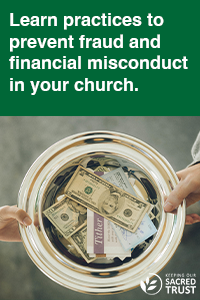Wondering how to approach a stewardship campaign in the era of COVID-19? Ken Sloane offers ideas that affirm the importance of the church’s ongoing mission while being sensitive to economic loss, attentive to people’s experiences and stories, and grateful for all gifts.
In a more “normal” time, congregational planning would be underway for the annual campaign. Though it may look different this year, a strong campaign can still be planned. Here are some ideas to spark your imagination.
1. Don’t skip the campaign because you can’t do it like before.
The old normal is gone. We are in a new place. If you skip an annual campaign this year, you risk leaving people with the impression that it really isn’t important. It will no doubt be different, but it can be an effective way to have people focus on what the church means to them and to the community. It is always helpful to focus on all that we are grateful for. For many people, the annual campaign is one of the few places where they can reflect on what their local church means to them, to the community, and to the world.
2. Emphasize that the building is closed but the church isn’t.
This should continue to be the theme communicated to church members and the community. The farther people are from the center of church activity and planning, the easier it is to think that if the building isn’t in use, the church is on hiatus.
The church I attend did a two-month worship series this summer on “The Church Scattered.” It reminded us that sometimes we are the church gathered; however, most of the time (167 hours per week, we were constantly reminded), we are the church scattered. We are still the church, even when we are scattered. Be sure your campaign includes stories of where God’s love has been made real by the church scattered, especially during the last six months.
3. Connection is more important than perfection.
Throughout the days since church buildings had to close as part of sheltering at home against the COVID-19 virus, we have seen countless examples of the benefit in keeping people connected — Zoom calls just to see familiar faces; texts to check in on loved ones or asking people if they need anything from the store. In viewing Jimmy Fallon streaming his television show from his living room with his children as guests or watching videos of pastors having sermons interrupted by barking dogs, we realize that in these pandemic days, most of us value connection over perfection. Keep this in mind as you brainstorm how your 2020 annual campaign might look.
4. Consider the home meetings campaign model, adding Zoom.
Many of us have been using campaign models centered around events like congregational meals, visitations, or large worship services where the faithful bring pledge cards to the altar. One of the less frequently used models incorporates all the members of the church family being invited into a variety of homes for fellowship to hear about the ministry plans for the church in the days ahead, with an invitation to make a financial commitment. This last model is easily adaptable to our present circumstance by substituting Zoom meetings (or other videoconferencing options) hosted by members of the campaign leadership team. For those who don’t have smart phones or computers with video cameras, the church can provide provisions for dial-in. Limit the number of people in each gathering to the number who can be displayed on one screen (25 usually). The pastor can join each group, or he/she can record a video message to be shared with each group.
5. Tell your story, but also listen.
If you incorporate the idea of the group meetings as part of your 2020 campaign strategy, be sure that you not only tell the story of how your congregation has been about its mission during the pandemic, but also include time to listen to those present. Develop a list of questions for participants to answer, such as: “Are you aware of places where we need to be reaching people and we are not?” Solicit community-wide needs. If people mention needs that your church is not equipped to address, determine if there are other groups better suited with whom your church could partner or support. You might ask people if they have felt connected and supported through the pandemic by the church. Are there ways that virtual worship could be more engaging?
6. Theme worship services to campaign.
Just as you would have done in an annual campaign in the “pre-corona days,” develop a theme for your worship that ties to your campaign. Plan a series of services and sermons that build interest and excitement about the campaign. Invite key leaders in the congregation to record short videos that connect to your campaign theme. Be sure to give clear directions for these recordings: good lighting, with phone close so audio is clear; indicate whether you want landscape orientation (like a movie) or portrait orientation (like a selfie).
7. Don’t rule out existing campaign resources.
While all the elements of a prepackaged campaign may not be adaptable for the current challenges, much of what is in these packages can be used. Most of the campaign materials offered by Cokesbury include study resources or themed devotionals, along with worship resources, sermon suggestions, and sample communications resources. All those can be adapted for use this year. Instead of using a printed mail-in pledge card, have somebody make a fillable PDF pledge card that can be emailed to people for them to complete and email back to the church. Remember, this is a great time to encourage more members to sign up for secure, recurring, electronic giving!
8. Be sensitive to economic hardships.
One of the most important considerations in planning a campaign during this time of pandemic is to be sensitive to those who are going through trauma in many forms: illness of family members or loss of loved ones; loss of income due to loss of business, furlough, or elimination of jobs. By simply including in your communication a phrase such as, “We are aware that some of you have been severely impacted by the current crisis and may not be in a position to increase your giving or even continue to give at last year’s level. Whatever you are able to do is a great blessing as we continue in ministry.” Be extra vigilant in reviewing prepared materials to catch anything that implies that everyone can increase giving.
9. Be bold in inviting some to step up.
On the other hand, you also might be bold enough to challenge those who have not felt the economic crunch of this past year. No doubt there are those who have continued to work and receive their pay, who are working from their homes and not commuting and filling cars with gas every week, not eating out as often or buying work clothes as often – and they received a stimulus payment on top! Find the wording that works in your context, but consider something like this: “If some of you have come through this pandemic time without too much economic turmoil and can find a way to step up giving, knowing that others in this body are struggling, it would be deeply appreciated by your finance team.”
10. Begin and end with gratitude.
Most important, begin and end every step, every email, every sermon, every tweet with “thank you.” Thank you for sticking with us through these tough times. Thank you for embracing ways of giving when we are not gathering every Sunday. Thank you for the random acts of kindness you are doing for your neighbors. Thank you for tuning in each Sunday morning and offering kind words of encouragement to those of us trying to make the technology work. Thank you for participating in Zoom meetings — they can get tiresome, but some of us have just needed to see your face. Thank you for wearing a mask to keep the rest of us safe. Most of all, thank you for believing that even if our building is closed, we are the church and we are open for the business of love, compassion, and hope.
This article originally appeared on the website of Discipleship Ministries and is republished by permission.
Related Resources
- Optimizing Annual Financial Campaigns Video Tool Kit, a resource from the Lewis Center
- Participation Is Up but Giving is Down for Many Congregations During the Pandemic by the Lake Institute For Faith & Giving
- 3 Ways to Reset Your Stewardship Ministry in the Midst of COVID-19 by Clayton L. Smith






